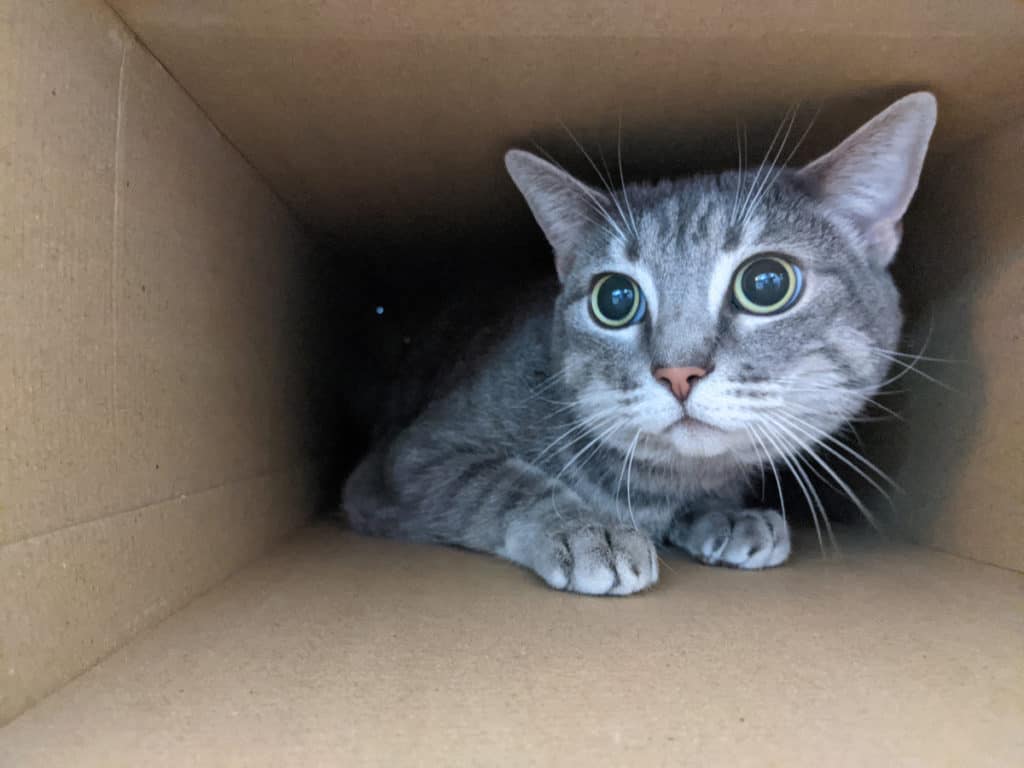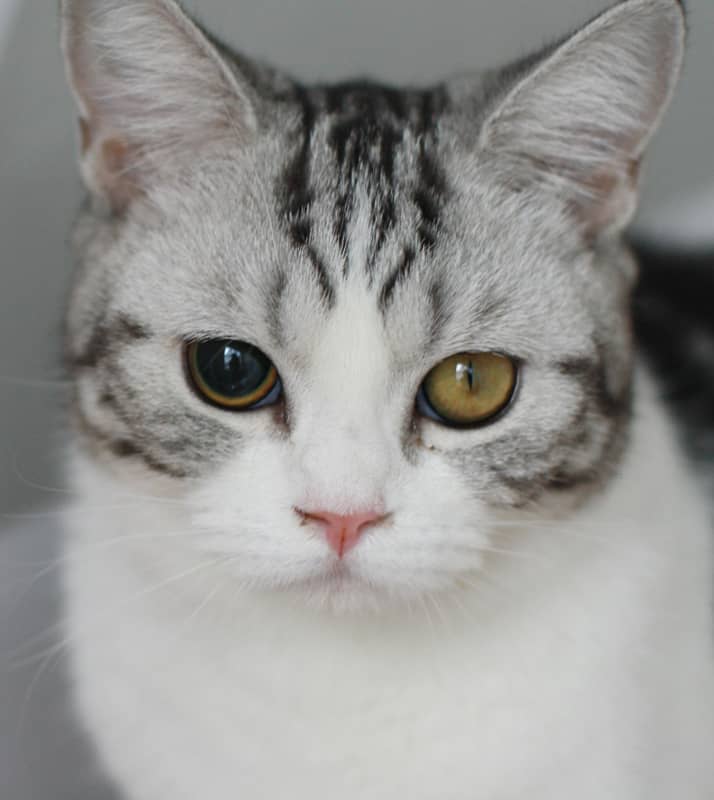The iris, or colored part of an eye, is quite distinctive in cats. It turns out that the cat’s eyes look and function in a specific manner to match their needs as predators.
The shape and size of a pupil do reveal a great deal about how animals live.
Your cat’s pupils can elongate to the point where they cover nearly the entire iris and broaden to around 135 times the original size. When compared to human pupils, which can dilate only up to 15 times, this is an astounding statistic.
Cats’ eyes are far superior to humans in this regard. It’s one of the reasons they see in the dark so well.

When there is scarce light, the cat’s vertical and thin-slitted pupils can dilate more than a round pupils, and they may expand far more comprehensively than the human pupils.
Why do the eyes of a cat change from round and wide-eyed to slits?
The pupil regulates the amount of light that enters an eye and works similarly to a camera’s eyepiece.
When a cat’s pupil dilates, it can range from a vertical slit to somewhat fully round. Because the cat’s pupil responds to the light intensity available, it dilates in dark or dim environments to permit the most amount of light on the retina.
On the other hand, the pupil gets slit-like and much smaller in brightness. The slits help to protect the cat’s eyes in bright sunlight when they are sunbathing.

As a result, the appearance of a cat’s eye varies according to the circumstances.
As they prepare to play, a playful or excited cat tends to have the pupils dilated.
Surprise or fear, on the other hand, could have the exact effect. Adjustments that occur as a result of fear or excitement should be temporary. As your cat relaxes, the apparent large pupil must shrink in size.
Naturally, cats are more playful and curious; an active young cat shows wide pupils due to fear or excitement. When a cat is more relaxed and sedate, it is less likely to dilate the pupils in response to excitement.
When Cats Have Pupils That are Different Sizes
Anisocoria refers to a condition in which the pupils of a cat’s eyes are of varying diameters. This condition can indicate a health issue or disease with your cat.
You should seek medical attention if your cat develops anisocoria.

Emotions and activities that change in cats pupils.
The orbs of eyesight are one of the most dynamic parts of a feline body.
Lets decode the feelings and thoughts hidden in a cats soul’s windows, their eyes.
Dilated pupils
Dilated or large pupils are yet another way to decipher the interpretation of a cat’s mystical eyes, and they often indicate that the cat is excited. Based on the circumstances, it could also be a sign of fear or surprise. When a cat is eager, it’s not uncommon for its pupils to elongate ultimately.
Constricted Pupils
It is among the most critical things about the cats’ eyes. If your cat’s pupils are constricted, it indicates that they are angry or agitated.
If the cat’s eyes are large and round, with pinprick-sized pupils, it means they’re getting ready to battle a potential threat. Keep an eye out!
Half-closed or squinted eyes
These kinds of eyes convey love, trust, and relaxation. If the cat appears to be about to drift off to sleep, it is relaxed and trusting of you. Also, it’s likely to doze off.
Mesmer-eyes
The cat’s eyes convey emotions through physical effects in eyelid position and pupil size, whether they’re blue, gold, green, oval, round, or almond-shaped.
The pupils of a cat can be as small as slits or as large as black pools. The eyelids can be completely open, squinted, or partially closed.

Emotional arousal, like fear, pleasure, aggression, or enthusiasm, or environmental arousal, for instance, a transformation in ambient levels of light, could be the reason for these changes.
Consider it more like a silent film: with the autonomic nervous system being the director, the star is the pupil, the eyelid is the supporting actor, and the rest of the cast consists of other facial structures, the tail, and the body. The external environment determines the setting.
Wide Open Eyes
Wide-open eyes indicate trust. Pupils usually dilate during friendly greetings. Soft brows, cheek rubs, and squinty eyelids are all possibilities. Accept it as a sign of faith and love.
Unblinking Stare
When your cat becomes interested, the pupils dilate slightly, and its eyes become more straightforward with the unblinking face of the person, object, or animal of interest.
The typical message goes, “I realize you’re there, but I wouldn’t want to fight.”
On the other hand, the unblinking stare is an interacting megaphone for would-be aggressive cats to communicate with their opponents; in multi-cat homes, with scarce resources like water, food, litter box, territory, and toys, it’s a paramount control message. Because of its subtlety, people frequently miss out on the cue.
Direct Stare
In feline vocabulary, a direct gaze is aggressive and threatening. The pupils of a feisty cat may be dilated and slit. Eyelids that squint offer protection against injury, and the pupils enlarge and brow furrow when they are in combative aggression. Avoid making eye contact with the feline; if you aren’t familiar with a confident cat, refrain from making eye contact to avoid injury.
Pain
Cats keep a poker face whenever it’s about pain; however, the eyes could quickly reveal pain in their bodies or eyes themselves. The pupils of a cat are elongated when it’s in pain. Based on the underlying disease or injury, a cat with pain may show constricted or dilated pupils. Squinting can also signify pain in the eye or body, and bloodshot eyes can also indicate it.
Slow blinks of the eyes
Lovey-dovey cat kisses. The cats express trust and love through slow blinks. The cat tends to have sleepy, dreamy looks, as if they are in a blissful state, with their lids partially closed. If you’re the fortunate recipient of the slow eye blink, reciprocate with the same to show your appreciation.
Using Eyes to Establish Dominance
Cats employ their eyes to establish a pecking order. A dominant kitten will maintain eye contact with his rival. In comparison, a submissive cat will frequently glance aside, showing that they have decided not to challenge the dominant’s authority.
The language of a cat’s eyes
Feline gestures are frequently subtle, perplexing, and contradictory. Because our cats cannot communicate their emotions verbally, humans must learn to read the body language, take into account the context of the situation, and recognize every individual’s quirks.
Read next: What Eye Colors Can Cats Have?
References
Pappas, S. (2015, August 7). Why cats have vertical pupils. livescience.com. https://www.livescience.com/51787-why-cats-have-vertical-pupils.html
Ray, C. C. (2014, June 2). How cats see in the dark. The New York Times https://www.nytimes.com/2014/06/03/science/how-cats-see-in-the-dark.html






